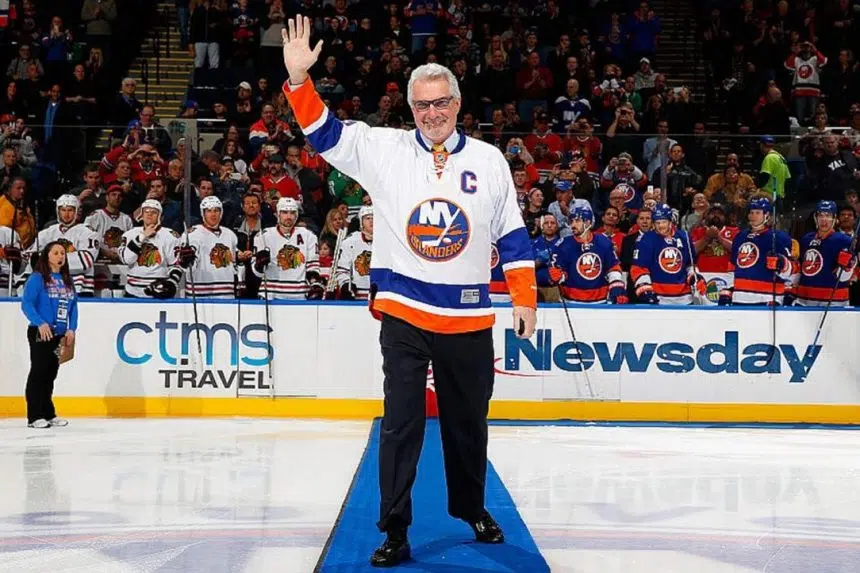At 6-foot-3 and 210 pounds, Clark Gillies was a physical presence, on and off the ice.
And yet …
“He’s the biggest (wuss) you’ll ever meet,” a chuckling Bob Bourne, one of Gillies’ former New York Islanders teammates, told the Green Zone’s Jamie Nye and Drew Remenda on Monday.
Gillies, a Regina Pats legend and a member of the Hockey Hall of Fame, died Friday after a battle with cancer. The Moose Jaw product was 67.
Bourne, who hails from Netherhill, first met Gillies when they were teenagers.
They played with and against each other over the years — including when Gillies played for the Pats and Bourne was with the Saskatoon Blades — before becoming teammates with the NHL’s Islanders prior to the 1974-75 season. They eventually became next-door neighbours as well.
“We just stuck together,” Bourne recalled. “We enjoyed each other’s company. Of course, he loved everybody.
“I was laughing over the weekend: I heard some of his jokes 53 years ago and I probably heard the same ones a year ago at some function — and I probably laughed just as hard.”
The Islanders came into existence prior to the 1972-73 NHL season, so the team was in its infancy when Bourne and Gillies joined the ranks.
Bourne said Gillies and the likes of Bob Nystrom and Garry Howatt set the tone in those early years for the dynasty that was to follow after players like Bryan Trottier and Mike Bossy were added to the roster. The Islanders won four straight Stanley Cup titles from 1980 through ’83.
“Clarkie was the leader,” Bourne said. “He fought (Philadelphia Flyers enforcer) Dave Schultz — (Gillies) was 20 years old — in Philly after Philly had won two Cups.
“He just showed a lot of courage. He was our leader for sure.”
Bourne told Nye and Remenda that Gillies hated to fight despite his size and toughness, but he did what had to be done to lead his teams. He also kept the mood light — for the most part.
“He was a very intense man,” Bourne said. “People don’t understand that about him.
“We used to have to stay in a hotel on Long Island during the playoffs. Clark and I lived beside each other, so we would go to the hotel together. The night before a game, he was pretty funny and open and stuff but we talked hockey. The next morning, when you were driving to that rink — and it’s about a half-hour drive — he never said a word. He was very intense inside the dressing room …
“He set the culture. Guys like Bryan Trottier and Denis Potvin, if you didn’t work as hard as they did, you were in deep crap. And that’s the way Clarkie was. You just worked as hard as he did and it really changed everything.”
But while Gillies was tough as nails, he couldn’t defeat them on at least one occasion.
“He dressed impeccably and he loved shoes,” Bourne remembered. “We were playing in Buffalo in the semifinals that year when we first won the Cup in ’80, and he goes down the street and there’s a shoe store there. Well, he buys three or four pairs and he wears this beautiful white or light beige pair of shoes to practice that morning. We get a hammer and a couple of nails and we nailed them to the floor.
“That dressing room cleaned out so fast; I was running out of there. I’ve never seen Clarkie get a red face, but he was red-faced that morning. He was so mad — and we were worried it was going to screw up his hockey game that night. But it didn’t.”
After Bourne and Gillies retired, they maintained their close relationship — and that allowed Bourne to make the determination of Gillies’ character mentioned above.
Their ties got even closer when one of Bourne’s sons married one of Gillies’ daughters.
That further explains why Bourne said he and his family had “a tough weekend” after Gillies’ passing.
“He was always so good to people and he made everyone feel like they were part of the conversation,” Bourne said. “We went on a lot of fishing trips together and there were a lot of guys who just wanted to hear Clark Gillies stories. He could sit there and regale them for hours and hours and hours — just a hilarious, good guy.
“(He was) such a good friend. He would have done anything for me and vice versa.”











